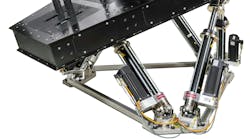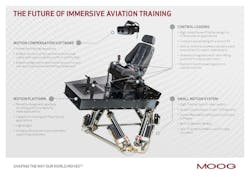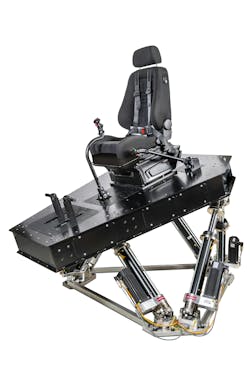The motion controls that design engineers use to model aviation dynamics have gotten more powerful with the introduction of virtual- and mixed-reality technology. For example, the mix of head-mounted displays and motion platforms for flight training devices, or FTD, now offer pilots a seamless, real-world sensation not unlike the full flight simulators employed by commercial airlines and militaries.
Simulators come in different varieties and full flight simulators (e.g., Level D) are the most sophisticated which incorporate six degrees of motion and realistic cockpit sounds. Pilots use full flight simulators (FFS) to stay current with their pilot's license without flying the actual aircraft.
FTDs, however, are a rung below FFS on the ladder of simulation; historically, FTD haven’t employed motion. FTDs typically consist of a physical cockpit and a projector or monitor. The airlines use FTDs, among other things, to train new hires on the way to achieving a type rating.
Since at least 2017, there have been requests and proposed scenarios for adding motion to FTDs. But research and tests showed most people experience discomfort, or even sickness, in an FTD supplemented with VR (virtual reality) and motion. This is why pilots and cadets have trained with static FTD and cardboard mock-ups. This motion sickness puzzled us, and we delved into solving the problem.
What we learned was that the correlation between the pilot's point of view, the movement of the FTD, and the physical simulator were not adequately synchronized. To overcome this motion sickness and skewed position of the pilot and training device, we determined the tolerance for FTD motion compensation must have a certain position and an angle error. The HMD tracking delay must also have a minimal tolerance.
READ MORE: Variable Speed Pump Drives Help Aircraft Simulator Mimic the Unthinkable
Better Synchronization of the Physical and Digital Improves Training Capabilities
With a head mounted display (HMD) and VR technology, pilots are immersed in a virtual environment where they interact with the physical cockpit through visualization that tracks the pilot’s body pose. With VR and MR (mixed reality) systems, there is a visual interface between the pilot and the physical surroundings, so the visual system complements the mocked-up cockpit.
We focused on perfecting the synchronization between the electrically actuated motion base and HMD. Milliseconds before the simulator generates an image for the pilot to see, the software we developed compensates for any move of the motion base and changes the position of the “aircraft” fed to the pilot’s HMD. Motion compensation software employing advanced algorithms and motion sensors marries real and virtual elements. And control loading technology seamlessly integrates the cyclic, collective, and pedals with the motion base and HMD.
As for the specifications, the FTD we developed weighs 1,000 kg, including a 300 kg payload with the pilot wearing an HMD and seated atop the motion base. The six-degrees-of-freedom electric motion base fastens on top of a platform measuring approximately 2.2 by 2.7 m, which is slightly larger than the FTD’s motion envelope. The system uses three phase power.
Communications for the system are handled with a controller talking to the system devices as well as a host. The FTD uses a real-time operating system which runs on a 64-bit computer and acts as a master EtherCAT node. Communications with the motion drives and control loading system, or CLS, also happen via EtherCAT.
The FTD can acquire and generate signals using IO devices that transfer data with EtherCAT, too. The FTD transmits host data (e.g., vehicle dynamics and generic motion base control) through the network via the user datagram protocol, UDP.
Choosing Electric Actuation Over Hydraulic
By way of background, the FFS industry converted from hydraulically actuated motion bases to electromechanical ones more than a decade ago. The advantages of electric over hydraulic in the FTD include eliminating the noise from the sound of the spindles and drives, which can interfere with training simulation.
Arguably, electromechanical actuators are safer than hydraulic cylinders, motors, and infrastructure because they eliminate high pressure oil hoses.
While hydraulic systems can reach much higher frequencies (e.g., up to 100 Hz), the motion capable FTD discussed here only requires an operating range of 3-15 Hz.
READ MORE: Sorting Out Linear Actuators
The Benefits of Motion Capable Flight Training Devices
The real gain from a motion equipped FTD for the aviation industry will be more affordable, realistic training. Simulator operators around the world want to train more pilots and cadets. But access to and the cost of FFS training can be prohibitive for pilots and cadets.
Motion capable FTDs can make training more accessible because airlines, flight schools, and militaries can purchase more of these systems and locate them closer to where pilots and cadets might live, work, or attend class.
For pilot certifications, the FFS will always be the gold standard and a requirement. But if an organization wants to train pilots or cadets for a special exercise and provide a realistic experience normally found only on a higher-level simulator, a high-fidelity FTD can now play a role.
If, for example, a pilot has a rating for a Boeing 737 and wants to get rated to fly the Boeing 777, then they could use a motion equipped FTD in their employer’s environment, instead of visiting an FFS training center, to reduce the amount of FFS time required.
For cadets attending an aviation-oriented college for flight school, a motion capable FTD will enable them to spend several hours familiarizing themselves with an aircraft’s cockpit and instruments. With the growing need for pilots, a motion capable FTD makes realistic training easier to come by and could even increase the number of qualified pilots for commercial or general aviation.
Watch Moog's video below demonstrating the capabilities of its motion equipped FTD during the Interservice/Industry Training, Simulation and Education Conference (I/ITSEC).
Digitalization’s Impact on Simulation
According to Gartner, Inc., digitalization is the process of employing digital technologies and information to transform business operations. Before the introduction of digitalization, a flight training device might have a small library of airports and landmarks to draw from for training. By introducing digitalization, motion capable FTDs can offer scenarios that combine virtual, augmented, and mixed reality.
For example, with digitalization, simulators can incorporate global satellite footage of nearly every location on Earth. With VR, the pilot in an FTD has a high-definition, 3D view that is no longer bound to a specific area for training. With an HMD linked to the FTD, students in locations around the world can connect with their peers for joint military exercises that incorporate training in the air, on ground, at sea, and with drones.
Digitalization enables teams to train with multiple simulators and work on coordinating a mission. With the addition of AI (artificial intelligence), simulators can create challenging environments, or more complicated training scenarios, because they can generate images from archival sets of data.
READ MORE: Digitalization Solutions and Benefits
Tapping a large, electric-powered 6 DOF motion simulator — the kind that moves an FFS for an airline — would be too costly, or even irrelevant, for the applications mentioned above.
One of the biggest advantages with the new FTD technology versus the motionless systems of the past is expanding the trainee’s view beyond 180 degrees. If, for instance, an organization wanted to simulate a search-and-rescue mission, a trainee could use a motion equipped training device with HMD to peer out and below a helicopter door. They could connect a hook while looking above to verify the position of the hoist. The trainee could also look around to check the clearance to bring aboard an injured person.
There are even applications beyond aviation training for the technology underpinning this new type of FTD. For starters, some logistics companies see potential for using electrically actuated motion platforms and digitalization to simulate realistic driver training.
There are rail companies that point to an opportunity to use these high-fidelity simulators and HMD to instruct locomotive engineers. There are also medical applications where hospitals could train physicians to perform vestibular exams. And first responders have expressed interest in creating motion equipped training devices for police officers and ambulance drivers to maneuver through traffic while avoiding collisions.
With the unique mix of an electric motion base synchronized with the HMD via motion control software, organizations can overcome an aspect of what has made simulation challenging to this day. The motion capable FTD is the basis for a simulator that suits an array of training needs.
This article was written and contributed by Noud van Bavel, marketing manager for Moog’s Simulation & Test group in Nieuw-Vennep, The Netherlands, and Rui Santos, a software engineer for Simulation & Test based at Moog’s Nieuw-Vennep facility.



